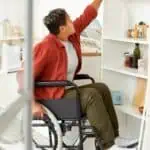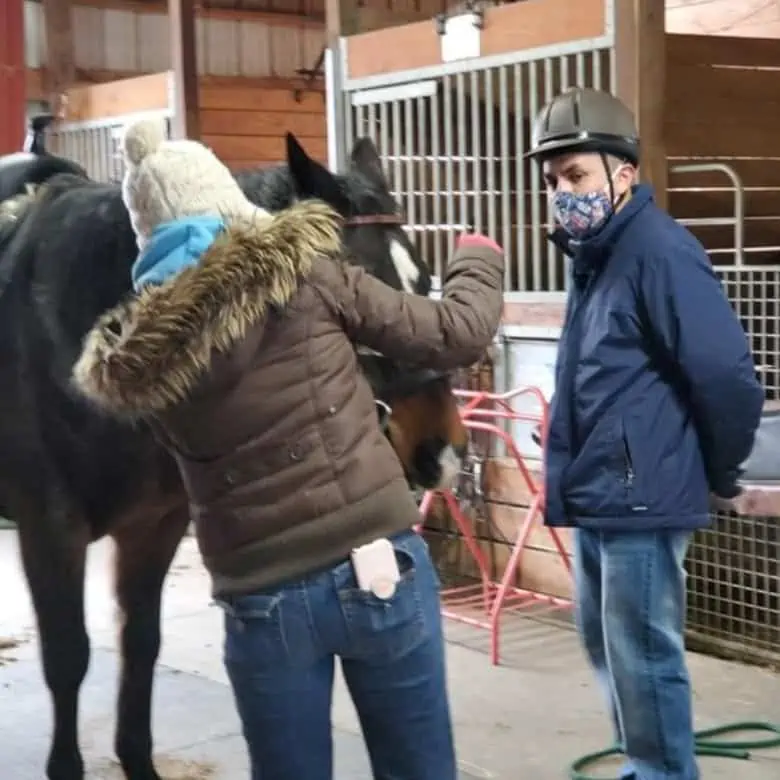What makes an Equine Assisted Horse Professional? What special knowledge or skill might they need to have in order to do this work?
An equine-assisted professional should have a grounding in basic horse care requirements: feeding and nutrition, grooming, de-worming, vaccination, farrier needs, and monitoring vitals and general health. He/She should know the signs of colic, lameness, and other issues. He/She should be competent in handling the horse and maintaining a sound facility and environment suitable for horses.
I feel it’s pretty important for every equine-assisted professional to take a step back from anything and everything they’ve ever learned about horses, and re-evaluate its completeness. Ideally, each horse professional develops a never-ending “learner’s mind” toward horses, a mindset that always questions the traditional ways while exploring and examining new ones.
What Does It take to Be an Equine-Assisted Professional?
The next tier of knowledge has to do with understanding horses from a psychological perspective. And it’s here that things get tricky. There are many horse people who may know what to do when interacting with horses but they don’t understand why the horse does what he/she does. Or, if they do understand, they only understand and interpret the horse from a limited point of view, i.e., the horse won’t get in the trailer, so therefore the horse is “stubborn”, “spooky” or “stupid”. Horses that won’t go in trailers are actually very smart…what metal cave on wheels, with no room to run away from predators, IS safe? None! But because we humans aren’t getting what we want when we want, we label the horse as the problem (rather than the way in which we are asking, or any number of other factors!).
From the basics of individual horse physiology and psychology, I think Equine Assisted Therapy and Learning Horse Professionals need to have a thorough understanding of herd dynamics. Horses are a social species, and how they interact, and what they need in a herd environment is very specific and ever-changing. Spending a substantial amount of time watching herd dynamics and how horses interact with each other, how they use their bodies to move each other, is one way to glean huge amounts of information about horse dynamics. What influences them? What do they choose as motivation—do they move each other over food, do they exert influence to move someone out of a choice shady spot? What are the things that matter? In the process of noticing these nuances, a horse professional can start to notice what matters to horses—both collectively and individually.
When it comes to other equids, such as mules and donkeys, it would be nice for the Horse Professional to have a basic understanding of their unique traits, not so much from a zoological point of view as from a psychological point of view. How do mules and donkeys interact with horses? How do they differ from horses in response to stimulus, how do their “default” settings track as a species, as well as their individual personalities?
As far as specific breeds of horses go, it’s important to be aware of breed tendencies without also making clichéd assumptions. Many people stereotype horses by breed—Arabians, Thoroughbreds, Paso Finos—and have significant biases and expectations. The breed may tend toward being very extroverted (love to be with other horses and people); they may have a long flight line (the distance they will run before stopping to reassess the danger). But there are individual exceptions to these tendencies. And one should never rule out how breed perceptions are sometimes the result of breed-specific training methods that can corrupt the basic psychology of the horse.
Equine Psychology
Equine psychology and body language then lead to the next level of important knowledge: horse handling skills from the ground. People who understand horse psychology and body language know that ground skills are not about pushing/pulling and more about influencing the horse, from catching and haltering, to safely extricating one horse from the herd, to leading them in from the field, to being comfortable and safe handling the horse from the ground in every situation. We can execute all of these basic functions more effectively when we come from a better foundation of understanding horse psychology and body language.
One of the first things I encourage folks to do if they are interested in learning about Natural Horsemanship is to stop using words around horses. As humans, we tend to rely more on words and pay less attention to our own body language. By inviting people to reverse the two, we invite them to become more aware of both their body language and the horse’s. This understanding can be cultivated in volunteers as well as professional staff.
Folks that work or volunteer around horses should know:
- a) how to determine if they and the horse are communicating effectively,
- b) if a given situation is safe or unsafe, and
- c) what to do to help the horse when communication isn’t working or the situation is becoming unsafe.
Want to learn more about horses, horse psychology, equine therapy and learning, and/or Natural Horsemanship? Volunteer! Attend and/or audit local Horsemanship Clinics. You can learn lots just by watching!
Shannon Knapp is Founder and Executive Director of Heart of Horse Sense, a 501c3 supporting Equine Therapy for Veterans, their Families and At-Risk Youth in Western North Carolina. She is a Trauma-Focused Equine Assisted Psychotherapy trainer, a professor in the Masters Program at Prescott College, and has over 20,000 hours of direct client contact in equine assisted psychotherapy and learning. She is the author of multiple books on the subject, including More than a Mirror: Horses, Humans and Therapeutic Practice.



